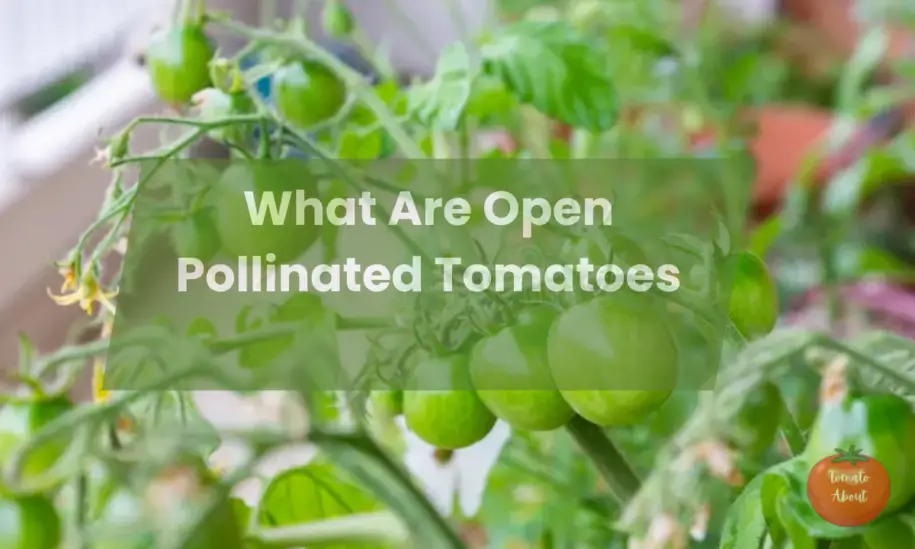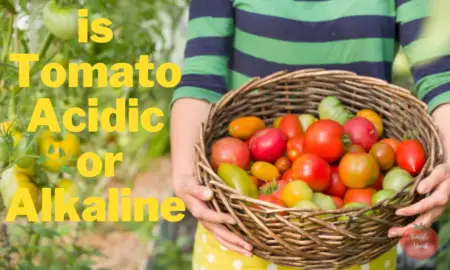Key Takeaways
- Open-pollinated tomatoes are naturally pollinated by insects, birds, wind, or other mechanisms, and seeds from the same variety will produce true-to-type plants.
- Open-pollinated tomatoes are prized for their superior flavor, making them a favorite among heirloom tomato enthusiasts.
- Open-pollinated tomatoes offer the benefit of seed saving, allowing you to preserve your favorite varieties and save on seed costs.
- These tomatoes maintain genetic stability over generations, ensuring that you can reliably grow the same type of tomato from saved seeds.
- Cross-pollination can occur among open-pollinated tomatoes of the same variety, preserving the distinctive traits of the variety.
- Open-pollinated tomatoes differ from hybrids, as hybrids result from crossing genetically distinct parent tomatoes and do not allow for seed saving.
Tomatoes are one of the most popular vegetables to grow in home gardens. And for good reason – their sweet, juicy flavor can’t be beat when picked fresh off the vine. When planning your tomato garden, you’ll come across terms like “open-pollinated,” “heirloom,” and “hybrid.”
With all these options, it can get confusing to figure out which tomato varieties are best for your needs. Let’s break it down so you can make the most informed choices.
What Are Open Pollinated Tomatoes?
Open-pollinated (OP) simply means the variety is pollinated naturally by insects, birds, wind, or other natural mechanisms. The pollen comes from the same variety of tomato plants to produce seeds that are true to type. This means if you save seeds from an open-pollinated Brandywine tomato and plant them the following season, you’ll get Brandywine tomatoes again.
OP tomatoes allow home gardeners to save seeds year after year while preserving all the delicious traits of a beloved variety. This is particularly appealing to heirloom tomato fans who want to grow cherished varieties from the past.
Unlike hybrids, the genetics of open-pollinated tomatoes remain stable over generations. So you can reliably grow the same tomato from saved seeds.
Key Benefits of Open-Pollinated Tomatoes
Superior Flavor. Since OP varieties are bred for taste rather than shipping ability or shelf life, they offer some of the best old-fashioned tomato flavors. Brandywine, Cherokee Purple, Black Krim, and other heirlooms pride themselves on incredible taste.
Seed Saving. As mentioned, you can save seeds from open-pollinated tomatoes to grow the following year. This allows you to create your own seed bank of favorite tomatoes tailored to your growing conditions.
Genetic Diversity. OP tomatoes encompass a wide range of shapes, sizes, colors, and flavors. This preserves greater tomato diversity overall rather than a few commercially focused hybrids.
Regional Adaptation. Many open-pollinated heirlooms have been passed down in certain regions for decades. They have had time to adapt to local growing climates and acquire natural disease resistance.
Cost Savings. Purchasing OP seeds just once provides a lifetime supply of seeds for that variety. Saving seeds avoids the expense of buying new hybrid seeds every season.
How Does Open Pollination Occur?
Tomato flowers contain both male and female reproductive parts. The anthers produce pollen while the pistils receive pollen to develop into fruits containing seeds.
With male and female components in such close proximity, tomatoes can self-pollinate when pollen drifts from anthers to pistils within the same flower. But cross-pollination between plants speeds things up.
Open pollination happens when pollen from one tomato plant fertilizes a different plant of the same variety. The seeds go on to grow true to type, maintaining all the distinctive traits of that variety.
Self-Pollination
Though tomato plants can self-pollinate, cross-pollination between separate plants improves fruit production and seed viability.
Cross-Pollination
Bees, hummingbirds, and other pollinators transfer pollen between different tomato plants. As long as the plants are the same variety, this cross-pollination still produces open-pollinated tomatoes.
But if cross-pollination occurs between different varieties, those seeds will grow into hybrids, not true to either parent.
How Do Open Pollinated Tomatoes Differ from Hybrids?
Hybrid tomatoes result from crossing two genetically distinct parent tomatoes, combining attributes of both.
Some advantages of hybrid tomatoes include:
- Higher yields
- Increased disease resistance
- Uniform sizing
- Longer shelf life
However, there are some downsides to hybrids compared to open-pollinated varieties:
- No seed saving – Hybrid seeds produce wildly variable plants, not true for parents.
- Lower nutrients – Hybrids are bred for looks and transport, not nutrition. OPs like heirlooms retain more nutrients.
- Reduced flavor – Shelf life and shipping come before flavor in hybrids. OPs offer a superior old-fashioned taste.
- Genetic weaknesses – The diversity of OP tomatoes makes them less vulnerable to diseases wiping them out.
- Higher cost – You must buy new hybrid seeds every year. OP seeds can be saved indefinitely.
What Is the Opposite of Open Pollinated?
The opposite of open-pollinated tomatoes would be hybrid tomatoes. Open pollinated varieties are bred through natural pollination within the same variety while hybrids are man-made crosses between different varieties.
While open-pollinated tomatoes allow for seed-saving and diversity, hybrids offer higher yields and disease resistance but lack seed-saving abilities.
Key Differences Between Open-Pollinated, Heirloom, and Hybrid Tomatoes
To summarize the distinctions between these three tomato types:
| Tomato Type | How They’re Pollinated | Seed Saving | Flavor | Shelf Life | Disease Resistance |
|---|---|---|---|---|---|
| Open-Pollinated | Within same variety | Yes | Excellent | Medium | Medium |
| Heirloom | Within same variety (for 50+ years) | Yes | Superb | Short | Low |
| Hybrid | Between different varieties | No | Moderate | Long | High |
Open-pollinated refers to natural pollination within a variety, enabling seed saving. Heirlooms are open-pollinated with a 50+ year history. Hybrids combine traits from different tomatoes but don’t allow seed saving.
Growing Tips for Open Pollinated Tomatoes
Succeeding with open-pollinated tomatoes in your garden is easy when following these tips:
- Start seeds early indoors 6-8 weeks before your last expected frost date. This gives plants a head start on the season.
- Provide support by staking, caging, or trellising plants. This keeps fruits off the ground and improves disease prevention. Many OP varieties grow quite large and benefit from support.
- Water regularly to maintain consistent soil moisture, preventing blossom end rot. Target water at the roots using drip irrigation or soaker hoses.
- Fertilize weekly with a balanced tomato fertilizer once blossoms appear. Proper nutrition is key for healthy tomato growth.
- Monitor for pests like hornworms, stink bugs, and tomato fruit worms. Catch any problems early before they spread.
- Promote airflow and promptly remove diseased foliage to prevent issues like blights and wilts from taking hold.
- Harvest frequently as fruits ripen to keep plants productive. Check plants daily once tomatoes start maturing.
Saving Seeds from Open-Pollinated Tomatoes
One big advantage of growing open-pollinated tomatoes is the ability to save seeds. Here’s the process:
- Select only the best, healthiest tomato plants from which to collect seeds.
- Remove seeds from fully ripe fruits and place in water to separate pulp from seeds.
- Allow seeds to ferment for 1-3 days until a film appears, then pour off debris. Viable seeds will sink to the bottom.
- Rinse seeds and dry thoroughly on towels or screens.
- Store dried seeds in envelopes or jars in a cool, dark place along with silica gel to absorb moisture.
- Label seeds carefully with variety, year collected, and any other details.
- Use freshly saved seeds the next season for best germination rates. Stored properly, seeds stay viable for 3-10 years.
With some planning, you can save seeds from year to year to always have your favorite open-pollinated tomato varieties on hand!
Recommended Open Pollinated Tomato Varieties
Here are some of the best and most popular open-pollinated and heirloom tomatoes to try in your garden:
- Amish Paste – Excellent for sauces with small pear shape and meaty flesh.
- Cherokee Purple – Stunning purple fruits with rich, complex flavor.
- Brandywine – One of the most popular heirlooms. Produces large pink beefsteak fruits with exquisite taste.
- Black Krim – Unique reddish-black skin and flesh with a salty, sweet flavor.
- Green Zebra – Cute small green and yellow striped zingy, spicy tomatoes.
- Roma – A classic paste tomato ideal for sauces, salsa, and canning.
- San Marzano – Another paste-type perfect for sauces with high yields of oblong red fruits.
- Mortgage Lifter – Legendary family heirloom producing huge 4-pound pink-red fruits.
- Abe Lincoln – Delicious 2-pound red beefsteaks.
- Hillbilly – Heavily lobed, low-acid yellow and orange striped tomatoes, great for fresh eating.
Frequently Asked Questions
What causes poor germination rates when saving open pollinated tomato seeds?
Some potential reasons for poor germination include storing seeds in warm, humid conditions leading to mold growth. Older seeds past their prime viability can also have low germination. Ensure seeds are thoroughly dried and stored properly in a cool, dark place for best results.
Can you grow open pollinated tomato varieties in containers?
Absolutely! Many open pollinated tomatoes grow well in containers. Focus on compact, smaller varieties and make sure containers are at least 5 gallons with drainage holes. Give them a quality potting mix and keep plants consistently watered. Add a trellis or cage for support.
How can you tell when open pollinated tomato seeds need to be replaced with fresh seeds?
If stored under optimal cool, dark, and dry conditions, tomato seeds remain viable for 3-10 years before germination rates decline. Track germination carefully from season to season. If you notice significantly poorer germination or weaker seedlings, it’s time to replace older seeds with freshly saved ones.
Wrapping up!
With their old-fashioned charm, a diverse range of shapes, colors, and irresistible flavors, open-pollinated tomatoes let you experience an authentic tomato taste. Their seed-saving abilities also allow you to pass down beloved heirloom varieties year after year. For an exciting tomato-growing adventure that reconnects you with Grandma’s garden wisdom, look no further than open-pollinated tomatoes!


